Marissa Eyanson, director of behavioral health for the Iowa Department of Health and Human Services, shares how her department is breaking down silos between its behavioral health and disability service systems to make it easier for Iowans to access care; Dr. Paul Petersen, director of the emergency preparedness program with the Tennessee Department of Health...
Marissa Eyanson, director of behavioral health for the Iowa Department of Health and Human Services, shares how her department is breaking down silos between its behavioral health and disability service systems to make it easier for Iowans to access care; Dr. Paul Petersen, director of the emergency preparedness program with the Tennessee Department of Health, explains how his state teamed up with ASTHO to strengthen its Healthcare Resource Tracking System (HRTS) and support emergency preparedness efforts; on September 16, the PHIG Partners Public Health Data Modernization Implementation Center Program will hold the first of two Q&A sessions on Wave 2 applications; and Thursday, September 18, ASTHO will host its second session in its three-part succession planning series to help public health agencies develop a more resilient workforce.
Iowa HHS: State of Iowa Launches New Behavioral Health and Disability Services Systems
ASTHO Resource: Public Health Preparedness
PHIG Partners: Public Health Data Modernization IC Program Wave 2 Q&A (Session 1)
ASTHO Webinar: Succession Planning Part 2 of 3: Laying the Groundwork
SUMMER JOHNSON:
This is the award-winning Public Health Review Morning Edition for Monday, September 15, 2025. I'm Summer Johnson. Now, today's news from the Association of State and Territorial Health Officials.
MARISSA EYANSON:
When the ideas work, we keep them, and when the ideas don't work, we let them go, and that's how we ultimately get to a space where the system itself is designed to serve Iowans and designed to be person-centered.
JOHNSON:
The Iowa Department of Health and Human Services is breaking down silos between its behavioral health and disability service systems. Marissa Eyanson is director of behavioral health for the department. She says the reorganization has helped make it easier for Iowans to access care.
EYANSON:
We've been really thoughtful about the need to be able to get to people sooner, instead of waiting for a crisis before we intervene. And we ultimately built ways to be able to focus the funding on solutions that work and let go of territorialism that had ultimately preserved things that didn't necessarily work or create good outcomes for Iowans.
JOHNSON:
The department worked to bring the systems together and leverage existing strengths to develop a safety net across the board.
EYANSON:
The full continuum means prevention and early intervention. It means treatment, it means crisis, it means recovery support, and that ultimately, in order to be effective, we have to do it all.
JOHNSON:
Eyanson says the new system has paved a clearer pathway to care by involving as many communities as possible.
EYANSON:
We've taken the approach that said that big system problems need a big team, so we included stakeholders like schools and law enforcement and hospitals throughout the design and build of the service system process.
JOHNSON:
To find out what your department can learn from Iowa's new model and the process they went through, you can head to the link in the show notes.
It's National Preparedness Month, and the Tennessee Department of Health is teaming up with ASTHO to boost its emergency preparedness efforts through strategic resource management. Dr. Paul Petersen is director of the emergency preparedness program with the department.
PAUL PETERSEN:
So, the scope of this ASTHO project was to prepare our Healthcare Resource Tracking System, or HRTS, for bi-directional data exchange with ASPR's federal system. The team modified our HRTS system to support 12 minimum data elements, and we really wanted to make sure that we could invest in federal interoperability standards.
JOHNSON:
HRTS allows Tennessee to do a lot.
PETERSEN:
We track hospital bed capacity, EMS deployments, medical resource availability. We actually can route patients through it, and overall, it informs our common operating picture.
JOHNSON:
What does this mean for communities across the state?
PETERSEN:
As a result of the project improvements that we've put into HRTS, we can now also track the last known quantity and location of a federally-deployed asset. This real-time intelligence helps us with rapid, data-driven decision-making and timely public health interventions.
JOHNSON:
ASTHO has many resources to help your department with emergency preparedness. We'll have a link in the show notes.
On deck this week, tomorrow, Tuesday, September 16 at 3 p.m. Eastern, the first of two Q&A sessions will take place hosted by PHIG Partners' Public Health Data Modernization Implementation Center Program. Public health agencies will have the chance to get answers on all things related to Wave 2 applications, including selection timelines and scope. If your agency is considering applying, you should attend. The second session will be on October 7. Check out the show notes for a link with more information.
Also this week, on Thursday, September 18, at 2 p.m. Eastern, ASTHO is holding a succession planning webinar. Agencies will learn how to build a resilient public health workforce through practical blueprints. This is the second session in a three-part series. You can register to attend using the link in the show notes.
That'll do it for today. We're back tomorrow morning with more ASTHO news and information. I'm Summer Johnson. You're listening to the award-winning Public Health Review Morning Edition. Have a great day.






